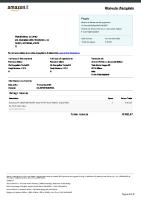Samsung in Bac Ninh [PDF]
1. Current situation http://cafebiz.vn/samsung-bac-ninh-va-samsung-hcmc-ce-cung-lo-ca-nghin-ty-loi-nhuan-samsung-taiviet
46 0 202KB
Papiere empfehlen
![Samsung in Bac Ninh [PDF]](https://vdoc.tips/img/200x200/samsung-in-bac-ninh.jpg)
- Author / Uploaded
- Joto Bui
Datei wird geladen, bitte warten...
Zitiervorschau
1. Current situation http://cafebiz.vn/samsung-bac-ninh-va-samsung-hcmc-ce-cung-lo-ca-nghin-ty-loi-nhuan-samsung-taiviet-nam-xuong-thap-hon-ca-khi-gap-su-co-galaxy-note-7-20190311101456476.chn 2. General reasons why Samsung invested in Vietnam (Production Factors, Market Factors and Gov Support). http://tapchicongthuong.vn/bai-viet/samsungs-investments-in-vietnam-reasons-and-consequences49598.htm 3. Negative impacts (less benefits than expected, environment issues, worker rights, and social impacts) http://tapchicongthuong.vn/bai-viet/samsungs-investments-in-vietnam-reasons-and-consequences49598.htm 4. Samsung in Bac Ninh 4.1 Entry Mode To a certain extent, the entry mode into a new market can be regarded as one element of crucial decisions under the company’s foreign market controls. Henceforth, it is not surprising to see different choices of entry mode from various MNEs, or even from one company. Samsung Electronics chose two entry modes, which are joint-venture and 100% foreign-owned mode, to enter the Vietnamese market. In the period from 1996 to 2008, the first affiliate that Samsung Electronics established in Vietnam was Samsung Vina Electronics Co., Ltd (SAVINA) – a joint venture with TIE Group Vietnam. Samsung considered Vietnam as a potential market to grow the company as the AFTA agreement was already passed between Vietnam and ASEAN and more importantly, Vietnam had a strategic plan and negotiation with WTO. However, customer’s trust and fierce competition from Japanese brands such as Toshiba and Sony, were the two main barriers that could undermine the company’s development and operation. For that reason, a joint venture was a safe decision for Samsung Electronics to enter Vietnam for the first time. As with the dominance in share capital, Samsung Electronics could decide strategic issues while delegating daily operation controls to its domestic partner. In the next period from 2008 to now, as the market provided many favorable business conditions, the company decided to redirect investment to 100% foreign-owned form. Therefore, in March 2008, the Vietnamese Government granted an investment license to Samsung Electronics to establish a 100% foreign-owned enterprise, which was called Samsung Electronics Vietnam with the total initial investment up to USD 670 million. The first plant was choses in Bac Ninh province with the scale of 100 ha land use, 2,300 employees and the estimated production capacity of 1.5 million phones per month. In the same period, Samsung Electronics acquired the rest 20% of share of the SAVINA company, making it become 100% foreign-owned enterprise. 4.2 Strategies in Bac Ninh
https://www.academia.edu/28880802/Hanh_trinh_20_nam_d%E1%BA%A5u_%E1%BA%A5n_Samsung_ t%E1%BA%A1i_Vi%E1%BB%87t_Nam
file:///C:/Users/Asus/Downloads/Foreign%20Direct%20Investment%20in%20Vietnam.%20A%20Case%2 0Study%20of%20Unilever_stamped.pdf https://news.samsung.com/vn/samsung-electronics-viet-nam-10-nam-kien-tam-tao-tam-vuot-ky-tich https://www.vietnam-briefing.com/news/samsung-build-us1-billion-plant-vietnam.html/ http://cafef.vn/nho-samsung-bac-ninh-xuat-khau-tang-gan-25-ty-usd-20180401133532915.chn https://vietnamnet.vn/vn/kinh-doanh/dau-tu/bac-ninh-thai-nguyen-doi-doi-tu-hieu-ung-ty-do-samsung445545.html https://www.vir.com.vn/samsung-affirms-25-billion-expansion-in-bac-ninh-47655.html http://www.antconsult.vn/news/samsung-invests-aggressively-in-bac-ninh-province.html https://vietnamnews.vn/economy/465241/fdi-giants-a-success-story.html#IDEhzvB8U2hDEhhg.97









